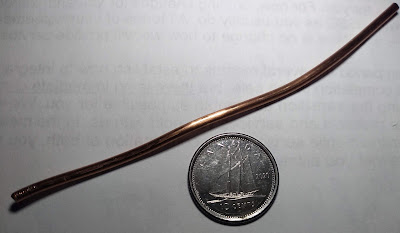For the early of my life I've relied on tables or similar references to look up things like copper ampacities and resistance. Now I just remember a few constants, and can calculate what I need to know.
The photo above is a 12 AWG copper wire, commonly used in building wiring in the US and Canada. It has a diameter of .0808 inches or 2.052 mm. When used for building wire, it is typically limited to carrying 20 amps of current by breakers or fuses. For circuits carrying more current, 10 AWG wire with a diameter of 2.587 mm can be used. For a change of 2 AWG in wire size, the change in diameter is always 1.26, and therefore the change in cross-sectional area is 1.26^2.
The cube of 1.26 is 2.0, so an increase in size of 3 AWG will double the cross-sectional area of the wire, and reduce the linear resistance by half. The resistance of 10 AWG wire is 1 ohm per thousand feet (304.8 m), so the resistance of 16 AWG wire, often used in extension cords, is 4 ohms per thousand feet at room temperature. The amount of heat generated in a wire is calculated with the formula P=I^2xR. If 10 amps is flowing through 1000 feet of 16 AWG wire, the power dissipated will be 10^2 x 4 or 400 watts. If the wire is 10 AWG, and the current is 20 amps, the power dissipated will be the same 400 watts. However voltage drop will be lower, since V = I x R. The resistance of 10 AWG wire is a quarter of 16 AWG, so the voltage drop in the 10 AWG wire with 20 amps will be half of the voltage drop of the 16 AWG wire with 10 amps.
The resistance of copper increases with temperature, by 0.393% per degree C, so increasing the temperature by 25 C will increase the resistance by almost 10%. Calculating temperature increase due to power dissipation is quite complicated, so it is common in electrical codes to consider an ambient temperature of 30 C, and a temperature rise in the wire of no more than 30 C. Because of that, most wire sold in Canada that is CSA certified will use insulation rated for at least 60 C. The most common category of wire used in residential construction, NMD90, has an insulation temperature rating of 90 C.
On a final note, a wire labeled 16 AWG might not really be 16 AWG. I generally trust the electrical distributors like Rexel and Wesco, however before using some battery wire from a discount hardware store I'd inspect it carefully first.

No comments:
Post a Comment